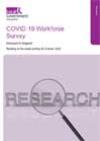This is report is part of a series of bi-weekly surveys of all councils in England, Wales and Northern Ireland collecting key workforce data on how the sector is responding to COVID-19.
An online survey is emailed to heads of human resources, or a nominated contact, in councils from England, Wales and Northern Ireland on alternate Wednesdays. The data requested relates to the week ending the preceding Friday. The intention is that this collection is the single national source through which such data is gathered, and it will, as appropriate, be shared with government departments and others in addition to providing comparator information for councils.
This report relates to the survey sent out on 4 November 2020 and covers the week ending 30 October 2020. The overall response rate was 57 per cent and covered around a third of the total workforce.
Key findings
- Some 34 per cent of councils reported recruiting additional staff (of any type including casual, agency, contingent, etc) in the week ending 30 October 2020. In total 1404 additional staff had been recruited in responding authorities: the median number of staff per authority was four and the mean was 23.
- More than half of respondent councils (112) recorded deaths in service since lockdown. A total of 350 deaths in service were reported by respondents since the start of lockdown (cause not specified).
- Twenty per cent of councils reported that they had furloughed at least one member of staff full time. In total responding authorities reported there were 3060 staff furloughed – full time in the week ending 30 October 2020, which was 0.6 per cent of the current workforce. The number of staff furloughed full time has gone down by 11 per cent compared to the previous fortnights collection (2755).
- In addition, 20 per cent of councils reported that they had furloughed at least one member of staff part-time. In total respondents reported there were 1642 staff furloughed part time in the week ending 30 October 2020, which was 0.3 per cent of the current workforce.
- The main reason given for furloughing staff was that the service had stopped (67 per cent) or that funding had stopped (28 per cent).
- Some 56 per cent of councils had redeployed staff. In total in the responding authorities there were 4493 staff redeployed in the week ending 30 October 2020, which was one per cent of the current workforce. The median number of staff redeployed was two and the mean was 26.
- Just over eight out of ten councils (83 per cent) reported that they had at least one member of staff unavailable for work. In total, respondents reported there were 28,433 staff unavailable for work in the week ending 30 October 2020, six per cent of the current workforce. The median number of staff unavailable for work was 38 and the mean was 150.
- Seventeen per cent of staff were unavailable through ‘self-isolation (other)’ and 47 per cent were unavailable due to ‘non-COVID sickness’.
- When asked whether individual services had enough staff to run them normally or not, the worst affected services were public health and schools: 12 per cent and 11 per cent of single tier and county councils, respectively, reported these services were operating with severe disruption due to staffing numbers. A further 29 per cent of single tier and county councils reported that schools were operating with moderate disruption. Also badly affected was adult social care, with 25 per cent reporting moderate disruption.
- When asked to assess the council overall, in terms of whether there are enough staff to run services normally or not, 60 per cent reported they were not operating normally.
- Councils were asked about the availability of personal protective equipment (PPE) and COVID-19 testing for staff. Ninety-five per cent reported they had about the right amount of PPE; whilst three per cent had less than they needed. Seventy-seven per cent said all the staff who need testing can access it.
- Looking ahead, councils were asked what they were currently considering doing about staffing within this financial year. Fifty-two per cent said they no substantive changes to staffing numbers, but 17 per cent said they were considering reducing the overall staffing level.
To view an accessible version of this document, please email [email protected].

